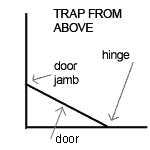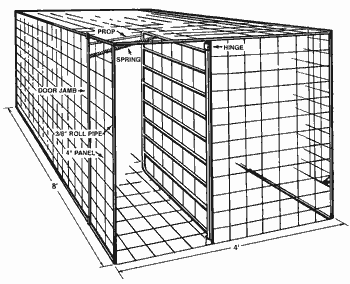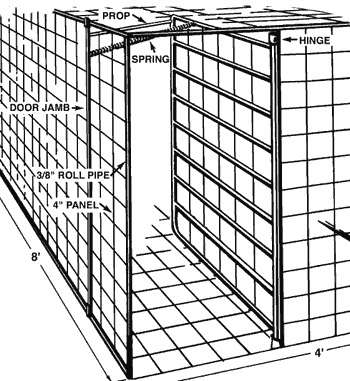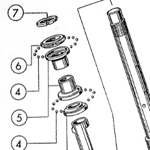This style of trap is the best portable trap style that we've found. We prefer the swing-style door as opposed to a root-style door -- a hog's natural tendency is to push up on things which makes the root-up door easier to escape from.
Materials:
- Frame: 1/4" steel rod or rebar or 1" square tubing
- Sides: 4" cattle panels (bull fencing)
- Spring for swing door (galvanized)
- Heavy duty hinges
Note: Excercise extreme caution if welding galvanized materials.
Building the Trap Frame
The standard size for hog traps is 4x8 feet. The height
will depend on the size of your cattle panels, (usually
52"). If your use these dimensions, use this cuts list:
Cuts list using framing material
| Long sides: | 8' x 4 | |
| Front/back cross pieces: | 46" x 4 | |
| Upright pieces: | 50" x 12 |
Construct your frame first by framing the two long 8' x 4' sides first. Use four uprights: one for each side, and two evenly spaced in the middle for added support. Though the picture doesn't show these additional uprights, we recommend them.
Then space your two completed sides 46" apart and weld in the front and back cross pieces. Now add one upright in the middle of the back, leaving the final three for your door assembly and door jamb.
The cattle panels should be tack welded to the frame wherever possible.
It is not necessary to include a bottom on the trap if the trap is heavy enough, though most include it. If you will ever want to transport the live hog in the trap, you'll need the bottom.
Door
Make the door separately and the install into the completed trap frame. For the recommend door of 24" x 49", use these cuts:
| Tall: | 47" x 2 | |
| Main cross pieces: | 24" x 2 | |
| Interior cross pieces: | 22" x 4 |
 You
want the door to fit in the trap with 1/2" clearance
top and bottom. Assemble the door so that the top and bottom
pieces overlap the upright pieces, resulting in the 24" x
49" door. Evenly space and weld in the interior cross pieces.
Cover in paneling.
You
want the door to fit in the trap with 1/2" clearance
top and bottom. Assemble the door so that the top and bottom
pieces overlap the upright pieces, resulting in the 24" x
49" door. Evenly space and weld in the interior cross pieces.
Cover in paneling.
Weld your completed door frame to the hinges, then to one of the remaining uprights. Position the entire assembly inside the trap frame so that the door closes against the side of the trap as shown in the pictures. The door should strike the edge of the trap at least 12" before the front of the trap. Weld in place.
Where the door closes against the frame, add the remaining two uprights to form a door jamb. This needs to be tough so that the hog can not escape.
Spring
The spring should have enough tension that it pulls the door closed after the trap is set, but not so much that small hogs can push it open from the outside after it has been closed. Attach to the door and then to the front corner of the trap.
<< Previous: Hog
Trap Overview
>> Next: Using the Trap



